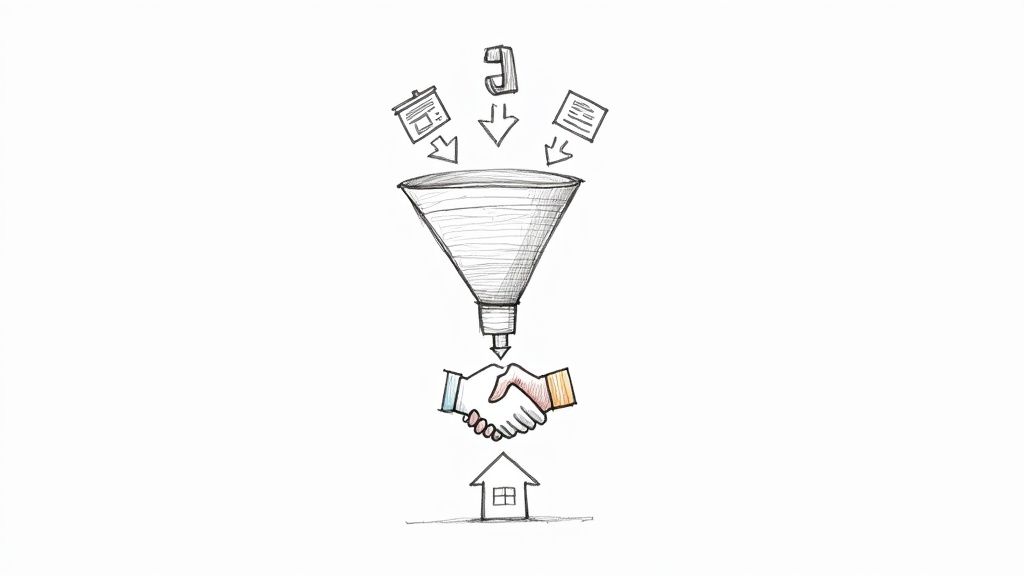In the home service world, a business lead is simply a potential customer who’s shown some interest in what you do. This isn't just a name pulled from a hat; it's someone who has actively raised their hand, signaling they might need your expertise.
Think of it as the first step in a conversation. They might call for a quote, fill out a contact form on your website, or get referred by a neighbor. Whatever the method, they've gone from being a stranger to a genuine opportunity for your business.
Understanding Business Leads A Simple Blueprint
Picture a business lead as the starting pistol in the race to win a new job. It's that first sign that a homeowner is moving from "just looking" to "ready to hire." For any home service pro, from plumbers to roofers, that distinction is what keeps the lights on.
A lead is more than just contact info. It’s a problem waiting for your solution. A homeowner’s furnace quits in the middle of a cold snap, or they’re finally ready to remodel their outdated kitchen. Each lead represents a chance to do what you do best and grow your business at the same time.
This visual gives you a great overview of how a simple inquiry can turn into a paying customer.
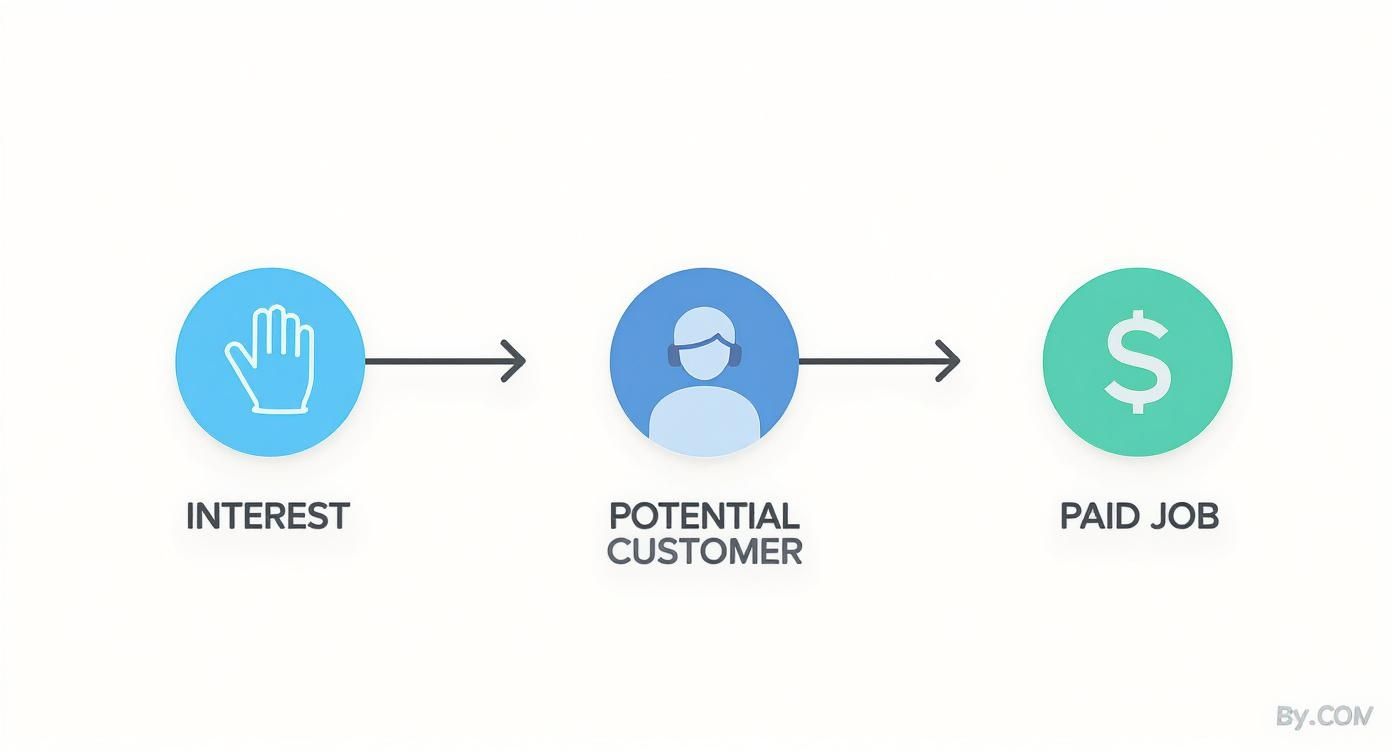
As you can see, the path is pretty straightforward. It all starts with a person's curiosity and, with the right steps, ends with a new source of revenue for your company.
From First Call To Finished Job The Lead Journey
To really understand how this works in practice, let's look at the typical journey a lead takes. The table below breaks down how a landscaper might see a simple phone call evolve into a completed project.
| Stage | What It Means | Example for a Landscaper |
|---|---|---|
| Lead | A person expresses initial interest in your services. | A homeowner finds your website and fills out the "Request a Quote" form for a new patio. |
| Prospect | You've qualified the lead and confirmed they're a good fit. | You call the homeowner, confirm their budget, and schedule an on-site consultation. |
| Opportunity | The prospect has a clear need, and you've proposed a solution. | After the consultation, you send a detailed proposal with the patio design and cost. |
| Customer | The opportunity becomes a paying client. | The homeowner signs the contract and pays the deposit to start the project. |
This process shows how crucial that first step is. Without the initial lead, none of the other stages can happen.
From First Contact to Loyal Client
How you handle that very first interaction—whether it’s a phone call, an email, or a direct message—sets the tone for the entire relationship. It's your first, and sometimes only, chance to make a great impression.
A prompt, professional response is often the single biggest factor in winning a job over a competitor. In fact, small businesses that blog consistently see 126% more lead growth than those that don't, proving that being a helpful resource pays off.
Nailing these initial conversations is non-negotiable. Every missed call or slow email response is a potential job handed to someone else. This is precisely why many successful contractors rely on a home service receptionist to ensure every single lead is captured and handled with care.
That kind of organized, professional approach is how you turn a ringing phone into a reliable pipeline of paying work.
Not All Leads Are Created Equal
Let's say your phone rings three times in an hour. The first call? A homeowner in a panic over a burst pipe—they need a plumber yesterday. The second is from someone who's just starting to get quotes for a new patio they're hoping to build this summer. The third isn't even a call; it's an email saying someone downloaded your "Spring Lawn Care Checklist."
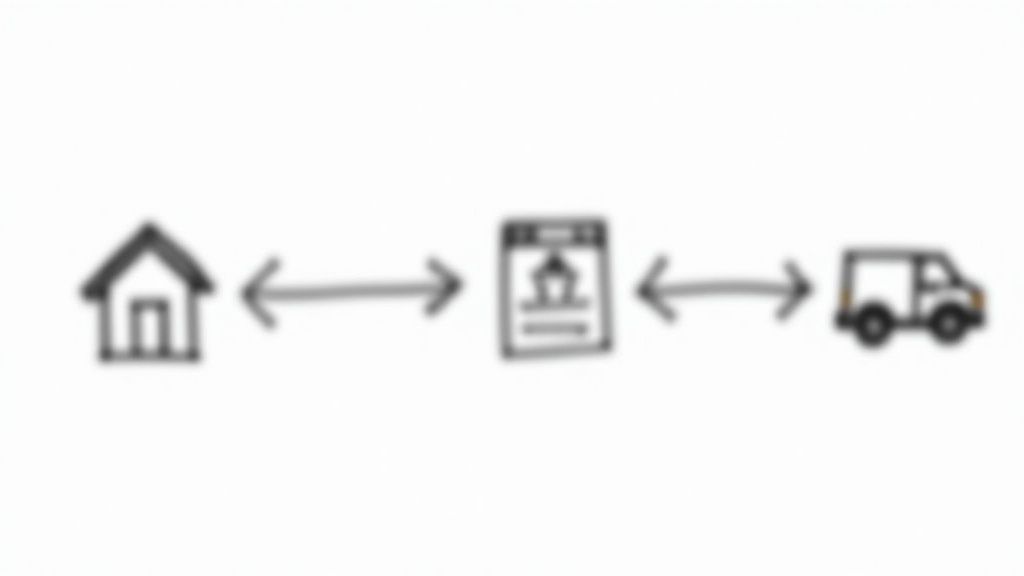
Technically, all three are "leads." But they're worlds apart in terms of urgency and what they need from you. Figuring out these differences is the secret to working smarter, not just harder. By sorting your leads by their "temperature," you can put your energy where it's going to count the most.
This is a huge deal, because most leads aren't ready for a hard sell. While a business might pull in nearly 1,900 leads per month on average, a staggering 81% of them aren't even ready for a marketing conversation, let alone a sales call. You can dive into more lead management statistics to see just how crucial this sorting process is.
Understanding Lead Temperature
The easiest way to think about this is to categorize leads as hot, warm, or cold. Each one needs a different touch to guide them from casual interest to a signed contract.
-
Hot Leads: These are your five-alarm fires. The homeowner with the burst pipe is a classic hot lead. They have an urgent problem, they know they need to hire someone, and they're ready to make a decision right now.
-
Warm Leads: This is the "planning phase" crowd. The person collecting patio quotes is a warm lead. They're actively researching and will likely hire someone soon, but they aren't in a full-blown emergency. They're a prime opportunity for a thoughtful follow-up.
-
Cold Leads: These folks have shown a flicker of interest, but that's about it. The person who grabbed your lawn care checklist is a cold lead. They know your name, but you'll need to nurture that relationship over time before they're ready to book a job.
By putting hot leads at the top of your list, you lock in the most profitable opportunities first. After all, you wouldn't spend an hour drafting a detailed quote for a "maybe next year" project while an emergency call goes to the competitor who simply picked up the phone faster.
Why Leads Are the Fuel for Your Business Growth
For any home service business, a steady stream of leads is the engine that drives everything. It's the difference between a thriving, fully booked schedule and the stress of scrambling to find the next job. Relying only on word-of-mouth is a recipe for a 'feast or famine' cycle that's impossible to manage.
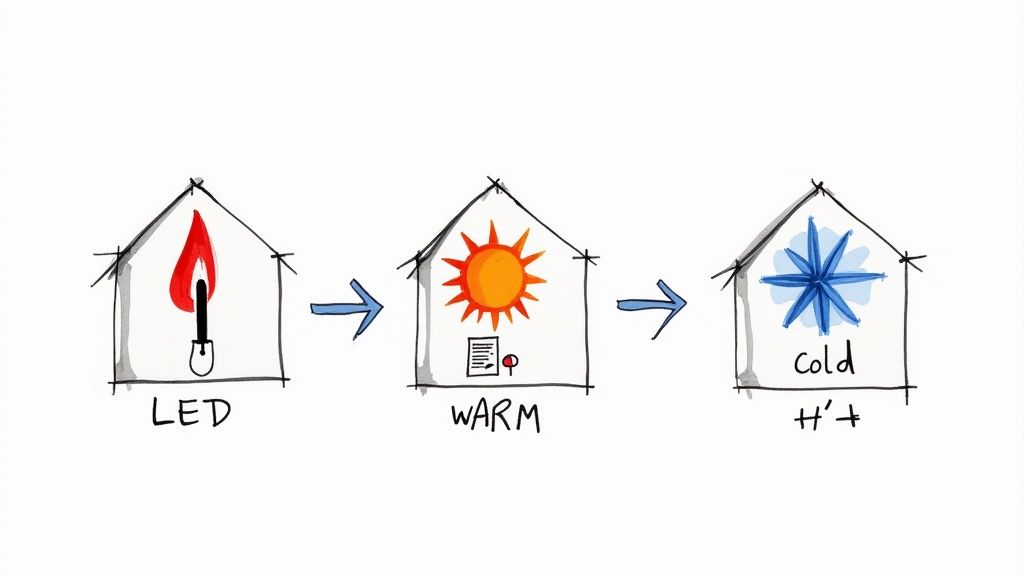
When you have a consistent system for generating business leads, you’re pouring fuel into every part of your operation, from making payroll to buying new equipment. Knowing how many potential jobs are coming your way lets you make business decisions with real confidence.
From Survival Mode to Strategic Growth
A predictable flow of inquiries changes the entire game. It allows you to shift from just reacting to whatever comes your way to proactively building the business you actually want. Instead of taking any job just to keep the lights on, you get to be the one in control.
This control has a massive impact on how you run things. Suddenly, you can:
- Hire with Confidence: You can bring on that new technician without lying awake at night, wondering if you'll have enough work to keep them busy.
- Invest in Better Equipment: That new truck or upgraded toolset? It becomes a smart investment, not a risky gamble, because you know the jobs are there to pay for it.
- Stabilize Your Cash Flow: You can finally smooth out those wild financial ups and downs, making it so much easier to budget and plan for the future.
Even more importantly, you can start being selective. You get to focus on the high-margin projects that actually grow your bottom line. This is a game-changer for small businesses—in fact, those who prioritize lead generation experience 126% more growth than those who don't.
Ultimately, a healthy pipeline of business leads gives you control. It’s the raw material you need to build a more profitable, stable, and scalable home service company, turning your craft into a predictable and successful enterprise.
Proven Ways to Generate More Home Service Leads
Once you understand why a steady stream of business leads is the lifeblood of your company, the next step is to actually start building your own lead-generation machine. This doesn't have to be complicated or expensive. It’s really about consistently putting a few proven strategies to work that are a perfect fit for the home services industry.
The whole point is to meet potential customers right where they are—the moment they realize they need help. You want your business to pop up in front of homeowners who are actively looking for a plumber, electrician, or landscaper right now.
Master Your Local Digital Footprint
For any home service business, your local presence is everything. It's not an exaggeration to say this is where the vast majority of your high-quality, ready-to-book leads will come from.
- Dial in Your Local SEO: Start with your Google Business Profile. This is non-negotiable. Keep your hours, service area, and contact info perfectly up-to-date. Actively encourage your happy customers to leave reviews, as this is one of the biggest trust signals for new prospects.
- Build a Simple, Professional Website: Think of your website as your digital storefront. It needs to have your phone number front and center, an easy-to-use contact form, and clear calls-to-action like "Call for a Free Estimate." Every single page should make it incredibly easy for a visitor to take the next step and become a lead.
- Run Targeted Social Media Ads: Platforms like Facebook are fantastic for this because you can target ads to homeowners in specific zip codes. You can show off photos of your best work or run special promotions to get people in your immediate area to call or fill out a form.
A strong local presence ensures that when a homeowner frantically searches "plumber near me," your business is one of the first they see. This kind of digital visibility is the modern-day version of being the most trusted name in the neighborhood.
Beyond just understanding why leads are crucial, exploring a variety of actionable small business lead generation strategies can give you a much broader toolkit for attracting all kinds of new customers.
Tap Into Professional and Commercial Networks
While residential customers are the bread and butter for most home service businesses, don't sleep on the value of commercial clients. People like property managers, real estate agents, and general contractors often need reliable pros on speed dial and can provide a steady stream of larger, recurring jobs.
This is where a platform like LinkedIn really shines. With over one billion users, it's the undisputed king of professional networking. In fact, research shows that 53% of B2B marketers use it specifically to find prospects, which makes it a goldmine for connecting with the decision-makers you need to reach.
No matter which strategies you focus on, remember that getting someone to reach out is only half the battle. If you don't have a solid system in place to capture that interest, the lead goes to waste. That's exactly where a 24/7 phone answering for home services solution can make all the difference, ensuring you never miss a call or an opportunity.
How to Turn Potential Customers Into Paying Clients
Getting a new lead is just the first step. The real work—the part that actually grows your business—is turning that initial spark of interest into a signed contract.
Think of it like tending a garden. You don't just toss some seeds on the ground and hope for the best. You water them, make sure they get sunlight, and protect them. It's that consistent attention that makes them flourish. The same goes for every single business lead you get.
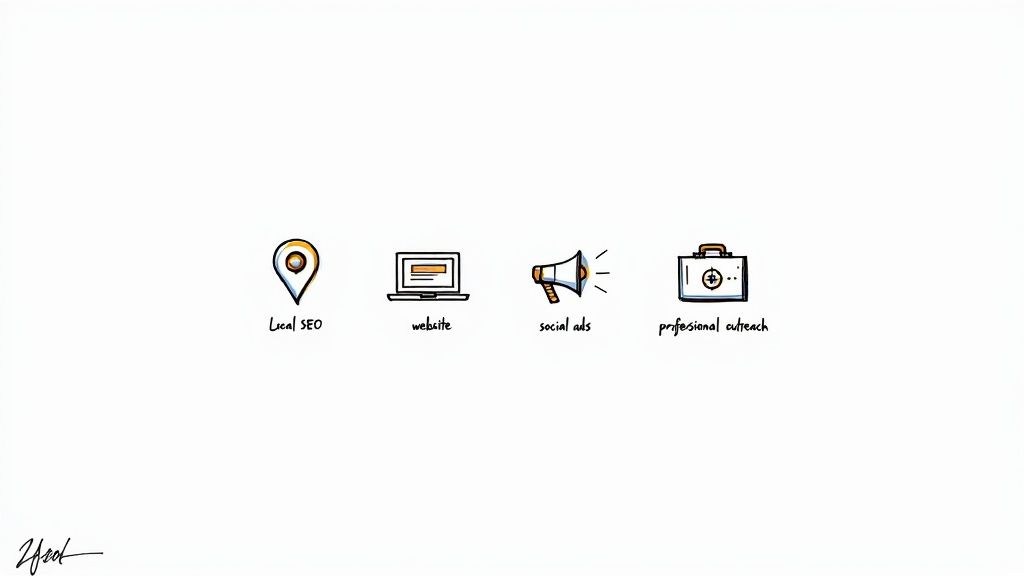
The small, consistent actions you take right after that first phone call or email are what separate the perpetually busy contractors from the truly profitable ones. These simple techniques are the heart of effective lead nurturing.
The Art of the Follow-Up
Your lead nurturing process kicks off the second a potential customer reaches out. Right here, in this moment, speed and professionalism are your biggest advantages. A quick, organized response tells them you're reliable and serious, building a foundation of trust from the get-go.
Nurturing is about building a relationship, not just making a sale. When you provide value before asking for their business, you establish yourself as a trusted expert. This makes the homeowner's final decision a whole lot easier.
Here are a few essential steps to nail every time:
- Respond Immediately: I'm talking minutes, not hours. In the home services game, the first pro to respond often gets the job, plain and simple. You can even use tools like the ultimate conversion bot to engage with website visitors instantly, so you never miss a beat.
- Send Professional Estimates: A clear, detailed quote shows you actually listened. This kind of transparency is a powerful trust-builder that immediately sets you apart from competitors with their vague, back-of-the-napkin proposals.
- Share Helpful Advice: Use simple email follow-ups to stay on their radar. Send something genuinely useful related to their project, like an article on "5 Tips to Winterize Your Pipes" for a plumbing lead. It keeps the conversation warm without being salesy.
Let's be honest, many business owners find these admin tasks drain their time. Learning how to hire a virtual assistant can be a total game-changer. It frees you up to focus on the actual work while ensuring every lead gets the attention it needs to become a loyal, paying client.
Answering Your Top Questions About Business Leads
Alright, let's wrap this up by tackling a few of the questions I hear all the time from home service pros. Getting a handle on these concepts will really help you build a solid lead generation machine for your business.
How Much Should a New Lead Cost?
This is the million-dollar question, isn't it? The truth is, the cost per lead (CPL) for home services is all over the map—it could be $30 for a quick repair or over $200 for something huge like a new roof.
But here’s the thing: obsessing over the cost is the wrong way to look at it. The real metric that matters is your return on investment (ROI).
Think about it. Would you be happy paying $150 for a lead? Maybe not. But what if that lead turned into a $5,000 project? Now that $150 looks like one of the best investments you've ever made. The key is to start with a budget you can afford, track where your best jobs are coming from, and then pour your resources into what’s actually working.
What Is the Difference Between Marketing and Sales Leads?
Imagine a relay race. Marketing runs the first leg, and sales runs the second.
A Marketing Qualified Lead (MQL) is someone who's shown some interest but isn't ready to buy just yet. Maybe they downloaded a "DIY Gutter Cleaning Guide" from your website. They're in the game, but they're still just browsing.
Then, that same person fills out your "Request a Quote" form. Boom. They just became a Sales Qualified Lead (SQL). They've raised their hand and are ready for a real conversation about a specific job.
The core idea is that marketing warms up the audience, identifying those with genuine interest. The sales team then steps in to engage with the prospects who have raised their hand and are actively seeking a solution.
What Is the Best Way to Track My Leads?
You don't need to overcomplicate this, especially when you're starting out. A simple spreadsheet is your best friend for tracking business leads. Seriously, that's it.
Just create a few columns:
- Lead's Name
- Contact Info
- How they found you (e.g., Google, Facebook, Referral)
- Service they need
- Status (Quoted, Won, Lost)
This simple setup is powerful. It instantly shows you which marketing efforts are paying off and ensures potential customers don't slip through the cracks. As your company grows and you're juggling more leads, you can always graduate to a dedicated Customer Relationship Management (CRM) tool.
At Phone Staffer, we specialize in making sure every lead you get is handled perfectly. We can hire, train, and place expert virtual receptionists and assistants in your business to answer every call, follow up on every inquiry, and turn more opportunities into paying jobs. Visit phonestaffer.com to learn how we can help you grow.

